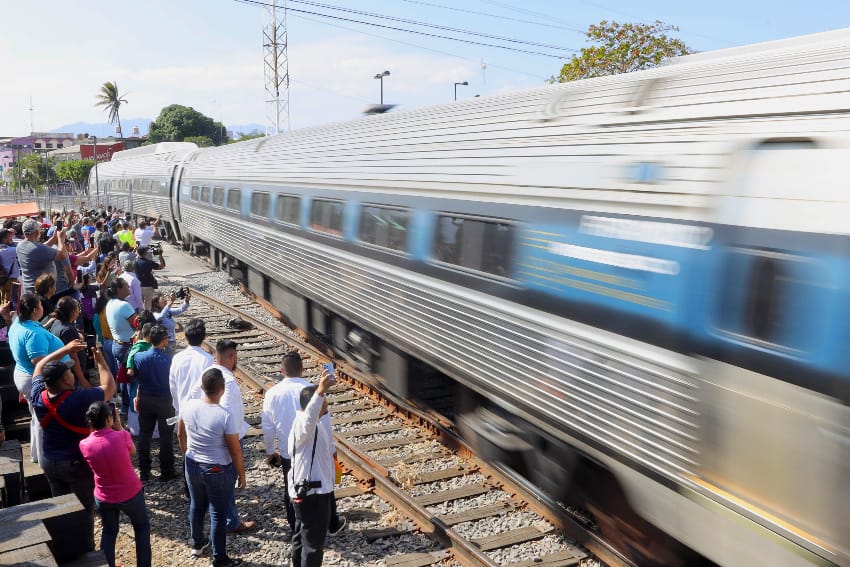What will it cost to finish AMLO’s rail projects? Sheinbaum answers

President-elect Claudia Sheinbaum said Thursday that it will cost her government an additional 83 billion pesos (US $4.4 billion) to complete and extend the Maya Train and Interoceanic railroads, the two major rail projects of the current administration.
Construction of both projects began during the government of President Andrés Manuel López Obrador, a train enthusiast who will soon conclude his six-year term.
Speaking at a press conference after meeting with current and incoming governors of southern and southeastern states, Sheinbaum said that an investment of around 35 billion pesos will be needed to adapt the Maya Train railroad so that freight trains can run on it.
Freight trains will run on the same tracks as passenger trains, but require “additional infrastructure” including intermodal terminals and freight storage facilities, she said.
Sheinbaum, who will be sworn in as Mexico’s first female president on Oct. 1, also said the Maya Train railroad will be extended to the Yucatán port city of Progreso, located north of Mérida on the Gulf of Mexico.
She said that the project to add freight capability to the railroad will take 1-2 years to complete.

Passenger services commenced in late 2023, and Sections 1–4 of the 1,554-kilometer-long railroad — which link Palenque, Chiapas, to Cancún, Quintana Roo, via Tabasco, Campeche and Yucatán — are now open, as is the northern part of Section 5, which connects Cancún to Playa del Carmen.
López Obrador recently said that the entire Maya Train railroad will open “at the end of August” or in “the middle of September.”
The Mexican government has already invested at least US $20 billion in the railroad. An average of just over 1,200 passengers per day used it during the first seven months of operation, a figure well below the government’s targets.
Investment of ‘around 48 billion’ pesos needed to complete Interoceanic rail project
Sheinbaum said that the completion of the Interoceanic Railroad project will be another priority for her government.
López Obrador inaugurated the main line between Salina Cruz, Oaxaca, and Coatzacoalcos, Veracruz, last December. The government envisions the modernized railroad as an alternative trade route for the transport of goods between Asia and North America and vice versa. However, freight trains have not yet begun running between the Pacific and Gulf coast port cities.
Sheinbaum said that her government will complete additional lines to the border with Guatemala, and through Tabasco to the port of Dos Bocas, where the new Pemex refinery is located.


Raymundo Morales, director of the Interoceanic Train project, said in late 2023 that the 328-kilometer-long FA Line between Palenque and Coatzacoalcos via Dos Bocas would begin operations in June 2024.
He also said that the 476-kilometer-long K Line between Ciudad Ixtepec, Oaxaca — a city about 60 kilometers north of Salina Cruz — and Ciudad Hidalgo, Chiapas, on the border with Guatemala, would open in the final quarter of this year.
However, the timeline for the FA Line — which will connect to the Maya Train railroad — was not met, and, based on Sheinbaum’s remarks, that of the K Line won’t be either.
The president-elect said that the completion of the two lines will also take 1-2 years.
It will cost “about 48 billion” pesos to finish them and complete other complementary Interoceanic Railroad projects, Sheinbaum said.
The Interoceanic Railroad is the cornerstone of the Interoceanic Corridor of the Isthmus of Tehuantepec infrastructure project, which will also include a chain of industrial parks.


The establishment of the trade corridor — touted by the government as an alternative to the Panama Canal — will allow Mexico to become a “world shipping power,” Navy Minister José Rafael Ojeda Durán said in June 2023.
Once freight trains are running between Salina Cruz and Coatzacoalcos, goods shipped from Asia, for example, could be unloaded in the former port and put on a train for a journey of approximately 300 kilometers to the Gulf Coast. The freight could then be reloaded onto another ship before continuing on to the Gulf or Atlantic coasts of the United States.
Sheinbaum has also committed to developing new passenger rail lines in central and northern Mexico and creating 10 new industrial corridors spanning all 32 federal entities of Mexico. She said Thursday:
“Just because we’re going to develop trains in the center and north doesn’t mean we’re going to leave the southeast abandoned. Investment will continue in the southeast.”
With reports from Proceso, La Jornada and El Financiero
Source: Mexico News Daily

